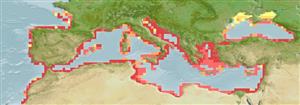Klassifizierung / Names
Namen | Synonyme | Catalog of Fishes(Gattung, Arten) | ITIS | CoL | WoRMS | Cloffa
Environment: milieu / climate zone / depth range / distribution range
Ökologie
seewasser; brackwasser demersal; tiefenbereich 10 - ? m (Ref. 3573). Subtropical; 47°N - 29°N, 11°W - 42°E
Eastern Atlantic: Mediterranean Sea, the Black Sea, Sea of Azov and Atlantic coasts from Morocco to France. Introduced to Iran and is now naturally occurring in the Caspian Sea basin (Ref. 50218).
Length at first maturity / Size / Gewicht / Alter
Maturity: Lm 21.3, range 17 - 22 cm
Max length : 40.0 cm SL Männchen/unbestimmt; (Ref. 3397); common length : 30.0 cm TL Männchen/unbestimmt; (Ref. 9987)
Adults usually in schools inhabit coastal waters (Ref. 3573); sometimes in lagoons and estuaries (Ref. 59043). Juveniles around 2.0 cm SL move to coastal lagoons and estuaries in summer and autumn (Ref. 59043). Adults are herbivorous feeding on algae and vegetal detritus while juveniles feed on zooplankton until about 3 cm SL, then on benthic organisms until 5 cm SL (Ref. 9987, 59043). Reproduce in summer (Ref. 2804). Oviparous, eggs are pelagic and non-adhesive (Ref. 205). Utilized for roe, but also fresh, smoked and frozen (Ref. 9987).
Thomson, J.M., 1986. Mugilidae. p. 344-349. In J. Daget, J.-P. Gosse and D.F.E. Thys van den Audenaerde (eds.) Check-list of the freshwater fishes of Africa (CLOFFA). ISNB, Brussels, MRAC; Tervuren; and ORSTOM, Paris. Vol. 2. (Ref. 3573)
IUCN Rote Liste Status (Ref. 130435)
Bedrohung für Menschen
Harmless
Nutzung durch Menschen
Fischereien: weniger kommerziell; Aquakultur: kommerziell
Tools
Zusatzinformationen
Download XML
Internet Quellen
Estimates based on models
Preferred temperature (Ref.
123201): 14.4 - 21.5, mean 18.4 °C (based on 154 cells).
Phylogenetic diversity index (Ref.
82804): PD
50 = 0.5005 [Uniqueness, from 0.5 = low to 2.0 = high].
Bayesian length-weight: a=0.01072 (0.00899 - 0.01277), b=2.96 (2.93 - 2.99), in cm total length, based on LWR estimates for this species (Ref.
93245).
Trophic level (Ref.
69278): 2.9 ±0.38 se; based on food items.
Generation time: 4.2 (3.4 - 5.5) years. Estimated as median ln(3)/K based on 12
growth studies.
Widerstandsfähigkeit (Ref.
120179): mittel, Verdopplung der Population dauert 1,4 - 4,4 Jahre. (K=0.2-0.3; tm=3-4).
Fishing Vulnerability (Ref.
59153): Moderate to high vulnerability (45 of 100).
Climate Vulnerability (Ref.
125649): Moderate vulnerability (39 of 100).
Nutrients (Ref.
124155): Calcium = 51.7 [14.1, 292.9] mg/100g; Iron = 0.722 [0.360, 1.278] mg/100g; Protein = 18.4 [17.0, 20.0] %; Omega3 = 0.73 [0.33, 1.67] g/100g; Selenium = 6.96 [2.86, 17.33] μg/100g; VitaminA = 12.3 [3.7, 38.5] μg/100g; Zinc = 0.621 [0.386, 0.987] mg/100g (wet weight); based on
nutrient studies.
